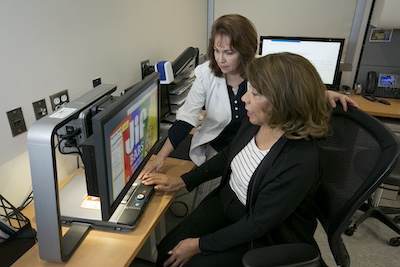Clinical training following our interdisciplinary treatment approach will include built in observation period to help transition to clinical practice allowing the fellow the necessary time to build strong foundational skills for the OT evaluation and treatment process. The fellow's weekly schedule may be comprised of 32 hours of non-mentored direct patient services, with 8 hours devoted to didactic learning, clinical education, and mentored service delivery. Clinical training will be delineated into Modules with emphasis placed on:
- Patient care within the low vision rehabilitation subspecialty, introduction to foundational principles of vision rehabilitation, and practicing clinical evaluation and treatments carried out by specialty certified occupational therapist(s).
- Mentoring opportunities with multidisciplinary team members (optometrist, ophthalmic technician, etc.).
- Increased independence with patient evaluation and treatment skills with mentor interaction and treatment plan development for conditions that range from near-normal visual impairment to total impairment with a wide range of functional deficits and co-morbidities.

Professional Presentation and Community Outreach
While working with the OT mentors, various clinical projects will be identified as possible topics for further program development. However, the fellow can choose their own project with approval of the mentor and Vision Rehabilitation team. The fellow is encouraged to share their project results at national or state conferences through lecture or poster presentations, or work with an OT mentor to submit a journal article for publication.
The fellow will be expected to participate in community awareness and educational programs that have been established or develop new educational materials to increase the audience’s understanding of low vision compensatory strategies, assistive technologies and access, functional mobility safety and community accessibility
Additional Training Opportunities
In addition to direct interaction with the multi-disciplinary vision rehabilitation team and the Duke OTD program, the Duke Eye Center regularly offers specialty lectures, grand rounds, seminars and conferences, along with low vision-specific clinical and journal club opportunities. As part of the program, fellows will also have opportunities to participate in additional Duke OT/PT based learning events that cover a broad range of topics.
Expected Program Outcomes
Our goal is to accept one fellow per fellowship year (August through July).
Our 52-week fellowship in Vision Rehabilitation consists of the following:
- General Orientation: Weeks 1 - 2
- Modules: focus on identified topics as stated in Curricular Content: weeks 3 - 33
- Scholarly and/or professional project: weeks 34 – 52, including continued clinical practice, mentoring and educational activities
- 2 weeks of approved leave
Breakdown of fellowship hours (Total Program hours: 2000)
- Orientation (Weeks 1-2)
- Clinical observation: 32 hours/week with multiple mentors
- Mentorship/Education: 8 hours/week
- Clinical Practice: 32 hours per week starting at Week 3 (Total: 1600 hours)
- Mentorship (Synchronous, 1:1 OT mentor): 4 hours/week X 50 weeks (Total hrs: 200)
- Education (Asynchronous, Synchronous): 4 hours/week X 50 weeks (Total hrs: 200)
- Direct 1:1 clinical mentoring in Vision Rehabilitation settings
- Weekly didactic curriculum that supports vision rehabilitation learning modules
- Optometry and ophthalmology-based clinics with clinical observation opportunities
- Opportunities to contribute to research and present at conferences
- This is a full-time, post-professional educational program spanning 12 months (August 2026 – July 2027). Those selected to participate in the fellowship will receive a salary (based off national and institutional benchmarks for trainees), full benefits, and be recognized as an official Duke employee during the length of the program.
- The program includes 32 hours per week of patient care, approximately 8 hours/ week of synchronous 1:1 mentoring and asynchronous coursework, case reports, information review, etc.
- The fellowship incorporates both synchronous learning experiences and clinical mentoring to progress the OT to the level of advanced specialty occupational therapy practitioner. As part of a large teaching hospital, our program offers a variety of unique learning experiences including professional observation opportunities with optometrists and ophthalmologists, participation in academic teaching, community outreach, and authorship or research opportunities. After successful completion of the curriculum, the fellow-in-training will be equipped with the knowledge, skills and professional competencies required to successfully work with clients with a broad range of conditions and levels of visual impairment.
LEARNING MODULES
MODULE 1: Introduction to Vision Rehab
MODULE 2: OT’s Role with Vision Impairment and Occupation
MODULE 3: Psychosocial and Cognitive Issues Related to Visual Disability
MODULE 4: Anatomy, Physiology, and Development of the Visual System
MODULE 5: The Eye Evaluation with Optometry
MODULE 6: Common Eye Diagnoses and Functional Impairments
MODULE 7: OT Vision Assessments
MODULE 8: Non-Optical Interventions and Environmental Factors that affect ADL/IADL Performance
MODULE 9: Neurological Conditions and Related Functional Impairments
MODULE 10: Assistive Technology and Occupation
MODULE 11: Optics and Optical Interventions
MODULE 12: Specialty Vision Impairment Issues/Oculomotor Dysfunction/Visual Perceptual Dysfunction/Driving Performance: Visual Skills and Compensation Strategies/Pediatrics: Visual Performance
MODULE 13: Scholarly and/or Professional Project